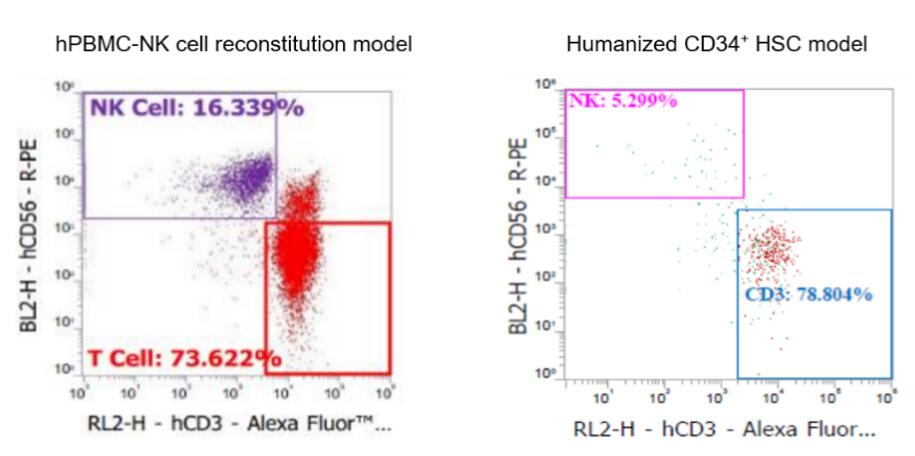- You are here: Home
- Disease Models
- Oncology Models
- Humanized Mouse Models
- Humanized PBMC Mouse Models
- hPBMC-NK Cell Reconstitution Model
Disease Models
- Oncology Models
-
Inflammation & Autoimmune Disease Models
- Rheumatoid Arthritis Models
- Glomerulonephritis Models
- Multiple Sclerosis (MS) Models
- Ocular Inflammation Models
- Sjögren's Syndrome Model
- LPS-induced Acute Lung Injury Model
- Peritonitis Models
- Passive Cutaneous Anaphylaxis Model
- Delayed-Type Hypersensitivity (DTH) Models
- Inflammatory Bowel Disease Models
- Systemic Lupus Erythematosus Animal Models
- Asthma Model
- Sepsis Model
- Psoriasis Model
- Atopic Dermatitis (AD) Model
- Scleroderma Model
- Gouty Arthritis Model
- Carrageenan-Induced Air Pouch Synovitis Model
- Carrageenan-Induced Paw Edema Model
- Experimental Autoimmune Myasthenia Gravis (EAMG) Model
-
Cardiovascular Disease Models
- Surgical Models
- Animal Models of Hypertension
- Venous Thrombosis Model
- Atherosclerosis model
- Cardiac Arrhythmia Model
- Hyperlipoidemia Model
- Doxorubicin-induced Heart Failure Model
- Isoproterenol-induced Heart Failure Model
- Arterial Thrombosis Model
- Pulmonary Arterial Hypertension (PAH) Models
- Heart Failure with Preserved Ejection Fraction (HFpEF) Model
-
Neurological Disease Models
- Alzheimer's Disease Modeling and Assays
- Seizure Models
- Parkinson's Disease Models
- Ischemic Stroke Models
- Acute Spinal Cord Injury (ASCI) Model
- Traumatic Brain Injury (TBI) Model
- Hypoxic-Ischemic Encephalopathy (HIE) Model
- Tourette Syndrome (TS) Model
- Amyotrophic Lateral Sclerosis (ALS) Model
- Huntington's Disease (HD) Model
- Intracerebral hemorrhage (ICH) Models
- Pain Models
- Metabolic Disease Models
- Liver Disease Models
- Rare Disease Models
- Respiratory Disease Models
- Digestive Disease Models
-
Urology Disease Models
- Cisplatin-induced Nephrotoxicity Model
- Unilateral Ureteral Obstruction Model
- 5/6 Nephrectomy Model
- Renal Ischemia-Reperfusion Injury (RIRI) Model
- Diabetic Nephropathy (DN) Models
- Passive Heymann Nephritis (PHN) Model
- Adenine-Induced Chronic Kidney Disease (CKD) Model
- Kidney Stone Model
- Doxorubicin-Induced Nephropathy Model
- Orthopedic Disease Models
- Ocular Disease Models
- Skin Disease Models
- Infectious Disease Models
hPBMC-NK Cell Reconstitution Model
Searching for a trusted CRO partner to propel your immunotherapy research forward? Look no further than Creative Bioarray. Our cutting-edge hPBMC-NK Cell Reconstitution Model serves as the cornerstone for precisely evaluating the genuine efficacy of your drug candidates. By nurturing mature human NK cells within a meticulously controlled cytokine milieu, our platform fosters the robust generation of highly functional NK cells, renowned for their exceptional cytotoxic prowess. Bid farewell to inaccuracies stemming from cell depletion or species-specific discrepancies; with Creative Bioarray's hPBMC-NK Cell Reconstitution Model, we're poised to revolutionize your research landscape.
Features and Advantages
- Highly adaptable human NK cell reconstitution model: Compatible with an extensive range of over 400+ CDX and 400+ PDX models, ideal for comprehensive evaluations of diverse NK-based therapies.
- Clinical-level NK cell reconstitution: Innovative methods can reconstitute 100,000 NK cells in mouse peripheral blood, similar to clinical level.
- Keep normal function of NK cells: With over 70% of total NK cells being CD16+ cells, which are closer to the situation in human peripheral blood.
- Avoid NK cells depletion: Our model addresses the challenges posed by NK cells depletion, enabling accurate assessments of Antibody-Dependent Cell-Mediated Cytotoxicity (ADCC), NK-related immune checkpoints (such as NKG2A), and cytokine effects (like hIL15).
Applications
- Immunotherapy efficacy evaluation: Conduct precise evaluations of investigational agents, elucidating their genuine therapeutic potential against a robust and representative NK cell landscape.
- Immune checkpoint exploration: Investigate the immunomodulatory mechanisms associated with NKG2A and their subsequent influence on NK cell functionality, unlocking potential novel therapeutic strategies.
- Cytokine effect analysis: Comprehensively analyze the efficacy of cytokines, such as human interleukin-15 (hIL-15), in enhancing NK cell responses, providing profound insights into immune modulation mechanisms and their applications.
Example Data
 Fig. 1 Effect of Imab362 (CLDN18.2 ADCC monoclonal antibody) on tumor volume. Imab362 exhibited significant pharmacological differences across various models, with the most pronounced efficacy observed in the hPBMC-NK Cell Reconstitution Model.
Fig. 1 Effect of Imab362 (CLDN18.2 ADCC monoclonal antibody) on tumor volume. Imab362 exhibited significant pharmacological differences across various models, with the most pronounced efficacy observed in the hPBMC-NK Cell Reconstitution Model.
 Fig. 2 Flow cytometry analysis of NK cell reconstitution levels: In the hPBMC-NK cell reconstitution model, a robust level of NK cell reconstitution is observed. Conversely, the Humanized CD34+ HSC model exhibits a comparatively lower level of NK cell reconstitution.
Fig. 2 Flow cytometry analysis of NK cell reconstitution levels: In the hPBMC-NK cell reconstitution model, a robust level of NK cell reconstitution is observed. Conversely, the Humanized CD34+ HSC model exhibits a comparatively lower level of NK cell reconstitution.
Quotation and Ordering
Equipped with clinical-grade NK cell reconstitution, featuring a predominant CD16+ composition, and a steadfast dedication to precise evaluations, Creative Bioarray stands as your ideal collaborator for groundbreaking discoveries. Contact us now to unlock the possibilities of the hPBMC-NK Cell Reconstitution Model and elevate your research endeavors to unparalleled new heights.
For research use only. Not for any other purpose.

